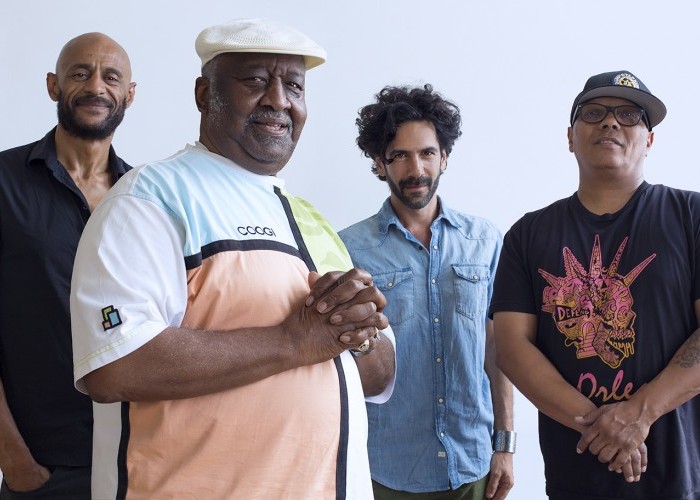Dec 9, 2025 12:28 PM
In Memoriam: Gordon Goodwin, 1954–2025
Gordon Goodwin, an award-winning saxophonist, pianist, bandleader, composer and arranger, died Dec. 8 in Los Angeles.…

Pete Shand (left), Bernard “Pretty” Purdie, Brian J and Ivan Neville collaborated on the new album Cool Down.
(Photo: Azumi Oe)Forget Aretha Franklin, James Brown, Herbie Hancock and the multitude of other artists with whom Bernard “Pretty” Purdie has played. What most animates the drummer is talk of himself at age 8, in Elkton, Maryland, coming to terms with what would become his signature contribution to music: the Purdie Shuffle.
The Shuffle—that celebrated swirl of “ghost notes” and rock-solid backbeat, at once connected and propelled by the whoosh of the hi-hat opening and closing—was suggested to him by the rhythms of the trains he heard as a youth.
By his own count, he’s been heard on 4,000 records, yet he claims a relatively modest 15 albums as a leader. So, it’s with some excitement that he has released Cool Down (Sugar Road), his first studio leader project in a decade.
The Purdie sound is identifiable throughout these 10 tunes, not least on the instrumental “Golden Tie.” With Purdie’s drums rumbling, the tune recalls the cadences of those trains from the past. But in his own estimation, the sound’s elements reveal themselves most clearly on ballads. The album’s closing number, “Stranded,” features Ivan Neville’s Hammond B3 organ backing the plaintive vocals of his uncle, New Orleans legend Cyril Neville. Despite the tune’s languid pace, it has a propulsive edge and, like most of the tracks on Cool Down, an air of spontaneity.
“I’d start out a groove by myself while the rest of the band was taking a break,” Purdie said. “Next thing I know, they’d jump into the song and away we go.”
Reflecting that, the writing credits for most of the tunes go to the core band—Brian J on guitar, vocals and percussion; Pete Shand on bass; and Ivan Neville on keyboards—along with Brian Gitkin. To Purdie, this is no small matter: “It was a group effort. Everybody wanted to contribute, so that’s how I look at things.”
For Purdie, that was not always the case. In a career spanning more than half a century, he said, the songwriting credit—and the lion’s share of the money—usually went to those who crafted the “single-note” melodies. And don’t even talk about sampling.
“I was the beat for so many records in the ’70s,” he said. “Folks have taken those albums and made their own albums out of them.”
Still, he has no regrets. “I know that I really should be paid more for helping out and supporting the young people today with their songs. But you know what? The man upstairs has given me all these good, fabulous years. He watches over me, and I know that.” DB

Goodwin was one of the most acclaimed, successful and influential jazz musicians of his generation.
Dec 9, 2025 12:28 PM
Gordon Goodwin, an award-winning saxophonist, pianist, bandleader, composer and arranger, died Dec. 8 in Los Angeles.…

Nov 13, 2025 10:00 AM
For results of DownBeat’s 90th Annual Readers Poll, complete with feature articles from our December 2025 issue,…

Flea has returned to his first instrument — the trumpet — and assembled a dream band of jazz musicians to record a new album.
Dec 2, 2025 2:01 AM
After a nearly five-decade career as one of his generation’s defining rock bassists, Flea has returned to his first…

To see the complete list of nominations for the 2026 Grammy Awards, go to grammy.com.
Nov 11, 2025 12:35 PM
The nominations for the 2026 Grammy Awards are in, with plenty to smile about for the worlds of jazz, blues and beyond.…

Drummond was cherished by generations of mainstream jazz listeners and bandleaders for his authoritative tonal presence, a defining quality of his style most apparent when he played his instrument unamplified.
Nov 4, 2025 11:39 AM
Ray Drummond, a first-call bassist who appeared on hundreds of albums as a sideman for some of the top names in jazz…








